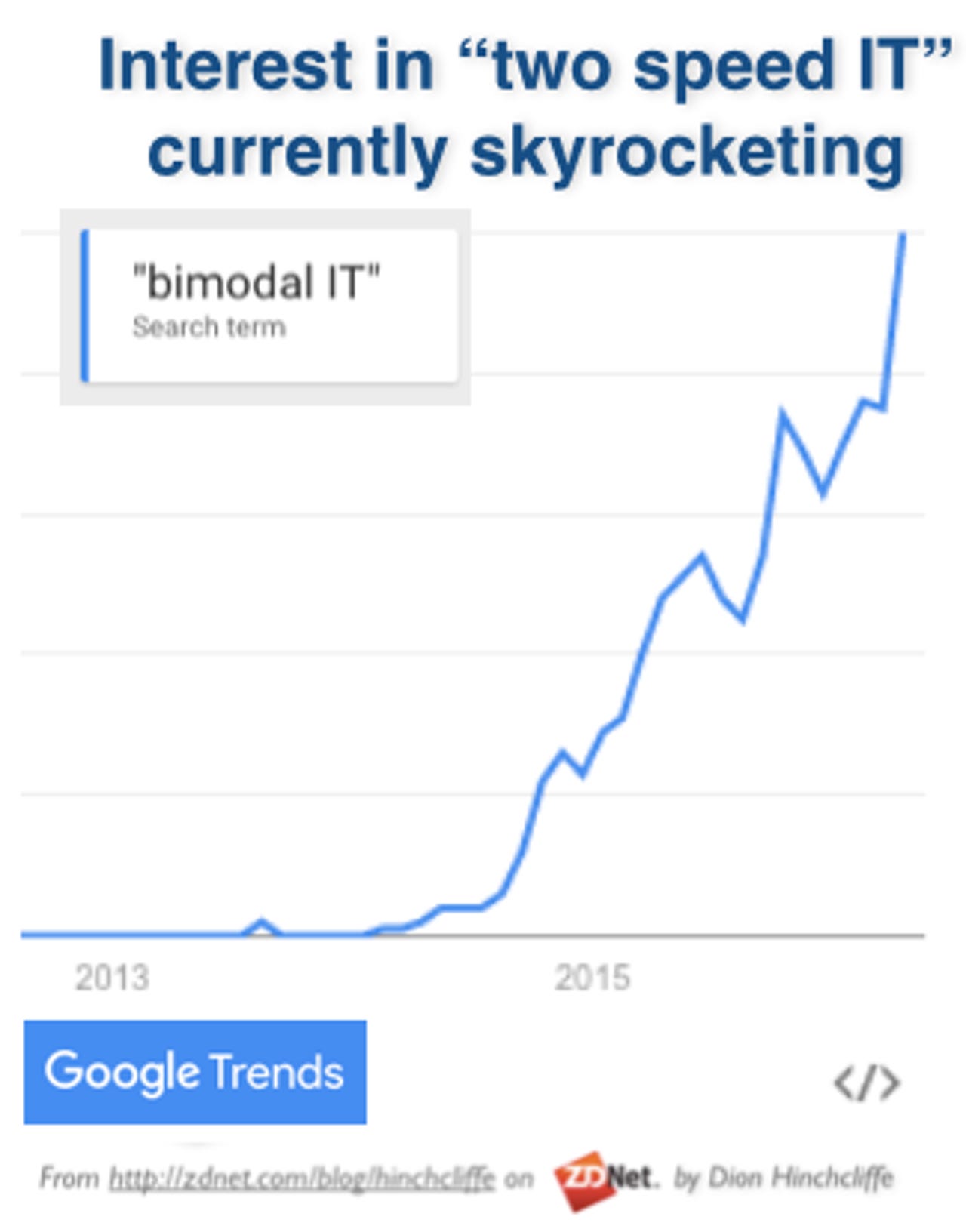IT leaders inundated with bimodal IT meme


Bimodal is the next big trend in IT, a dual speed model for enabling an effective mixture of stable, well-managed core systems and applications that change infrequently, while simultaneously unleashing agility and innovation along the edge of the organization via rapidly developed new digital solutions using the latest emerging platforms, technologies and processes.
Or bimodal is an overly-simplistic and practically flawed black-and-white template that doesn't align with how IT systems actually need to be developed and managed in an increasingly complex and nuanced world.
Either way, IT executives and the teams they lead will soon be required to weigh in on a concept that is now breaking out well beyond technology departments.
Not sure how big the bimodal debate has become? The U.S. Federal CIO Tony Scott is currently pitching bimodal as the next big initiative to deal with the government's vast hybrid portfolio of legacy and next-gen applications. "You have to have some way of managing the old stack and the new stack", Scott said this week at an industry event.
The origin of bimodal IT is credited to Gartner, which has been developing perhaps the most sophisticated and detailed research around the way organizations are varying the speed and formality of IT enablement. The analyst firm has doubled down recently on the concept with its latest CIO Agenda Report for 2016, which is literally packed beginning-to-end with data and analysis on bimodal IT trends.
Here's what Gartner's oft-quoted IT glossary glossary entry for bimodal IT actually says:
Bimodal IT is the practice of managing two separate, coherent modes of IT delivery, one focused on stability and the other on agility. Mode 1 is traditional and sequential, emphasizing safety and accuracy. Mode 2 is exploratory and nonlinear, emphasizing agility and speed.
At first glance, it certainly seems to make sense, and from my perspective bimodal is intellectually useful as a concept in creating a dividing line between legacy technology efforts that change much more slowly and must be managed more carefully on one side and high velocity new digital projects that must more faithfully match the rate of exponential change of market conditions today, while also effectively applying the latest technologies and techniques.
Where the concept breaks down, as I explored in my original critique of bimodal, is in actual execution. The real world of technology and the activities that make it bear fruit cannot be neatly compartmentalized into a dual structure. Not only do the actual needs and demands of individual IT initiatives vary widely, the team skills and processes on the ground are unique for nearly every project as well.
Furthermore, hard-won experience has shown that just two modes don't play that well together, generally requiring at least one intermediate layer. Simon Wardley, an industry colleague who maintains perhaps the sharpest perspective on the shortfalls of taking a basic mental model of bi-modal and using it for realization, notes that pioneers and town planners, the essential roles in bimodal, are essentially incompatible. Other well-known industry figures, like Jason Bloomberg, hold a similar opinion of bimodal.
To make the issue more uncertain -- and perhaps nudging the debate a bit into the realm of farce -- Gartner' competitor Forrester, has gone on record saying that bimodal is a false promise and really only one speed of IT is appropriate: Fast.
Multimodal IT: Speed and Agility is a Continuum
So what are IT leaders to do and how should they respond to a growing chorus of discussion on dual speed IT? While I've been searching for examples of bimodal IT departments, I have not so far been fortunate enough to find one. Sidenote: Please do contact me if you have a bimodal adoption story to share. What I have encountered are IT leaders looking at what for lack of a standard phrase I'd call multispeed IT. One CIO I talked with recently even said they believe they actually have five speed IT, depending on the requirements.
A useful thought experiment then is to look at the diagram above of some of the typical practices of the different speeds of IT. This is far from exhaustive, but even this view shows the sheer combination of practices that are likely to be applied to a given IT development or implementation project within the same organization, depending on the skills, experience, and needs of those involved.
At this point, as it's likely that bimodal IT will enter into IT department scorecards and bandied about as a best practice. To prepare, IT leaders should maintain a detailed accounting of their evaluation of the approach and how they adapted it to their organization, as a more granular set of multimodal practices or other similar set of constructs. As always with IT, education and communication are often one and same. Effective IT leaders will communicate how the requirements of the business dictate the specific portfolio of processes, from Kanban, agile, lean, and devops on one end of the spectrum to SDLC and six sigma on the other.
In short, as companies increasingly face the harsh realities of the needed scale and speed of digital transformation, establishing a IT playbook that allows the most flexibility and adaptation to market conditions and IT capabilities is the most practical solution. As my ZDNet colleague notes, today's CIO must 'push change at the right pace.' Define the models for the pace of change on your own terms, using your own model, for your organizations range of needs, with best lessons learned from the industry is my current advice.
Additional Reading